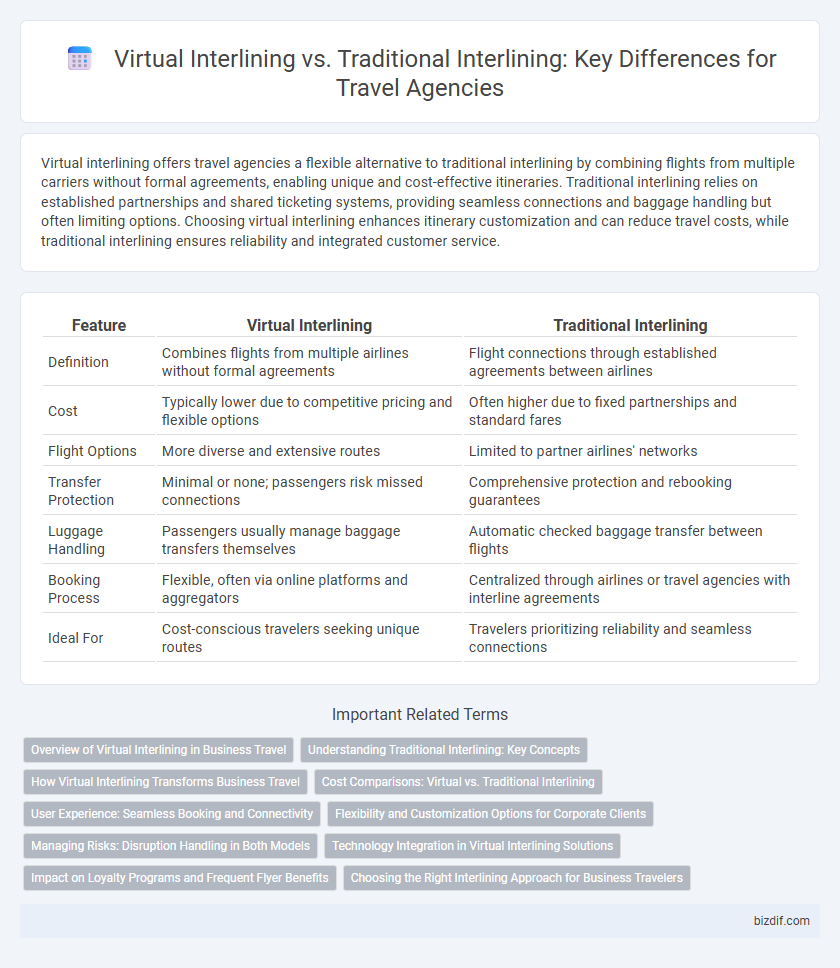Virtual interlining offers travel agencies a flexible alternative to traditional interlining by combining flights from multiple carriers without formal agreements, enabling unique and cost-effective itineraries. Traditional interlining relies on established partnerships and shared ticketing systems, providing seamless connections and baggage handling but often limiting options. Choosing virtual interlining enhances itinerary customization and can reduce travel costs, while traditional interlining ensures reliability and integrated customer service.
Table of Comparison
| Feature | Virtual Interlining | Traditional Interlining |
|---|---|---|
| Definition | Combines flights from multiple airlines without formal agreements | Flight connections through established agreements between airlines |
| Cost | Typically lower due to competitive pricing and flexible options | Often higher due to fixed partnerships and standard fares |
| Flight Options | More diverse and extensive routes | Limited to partner airlines' networks |
| Transfer Protection | Minimal or none; passengers risk missed connections | Comprehensive protection and rebooking guarantees |
| Luggage Handling | Passengers usually manage baggage transfers themselves | Automatic checked baggage transfer between flights |
| Booking Process | Flexible, often via online platforms and aggregators | Centralized through airlines or travel agencies with interline agreements |
| Ideal For | Cost-conscious travelers seeking unique routes | Travelers prioritizing reliability and seamless connections |
Overview of Virtual Interlining in Business Travel
Virtual interlining enhances business travel by allowing seamless connections between flights from different carriers that do not traditionally cooperate, optimizing routes and reducing costs. This innovative approach leverages advanced algorithms to create customized itineraries, improving flexibility and convenience for corporate travelers with tight schedules. Virtual interlining eliminates dependency on alliance partnerships, offering access to a wider range of flights and potentially shorter travel times compared to traditional interlining.
Understanding Traditional Interlining: Key Concepts
Traditional interlining in the travel industry involves formal agreements between airlines to coordinate routes, schedules, and baggage handling, enabling seamless passenger transfers across multiple carriers. This system depends on established codeshare partnerships and airline alliances to offer integrated ticketing and smoother travel experiences. Understanding these key concepts highlights the structured collaboration that underpins traditional interlining, contrasting with the more flexible but less coordinated virtual interlining approach.
How Virtual Interlining Transforms Business Travel
Virtual interlining revolutionizes business travel by seamlessly connecting flights from multiple airlines that do not have formal partnerships, offering greater route flexibility and cost savings. This approach enhances itinerary customization and reduces travel time by leveraging data-driven algorithms to find optimal flight combinations. As a result, travel agencies can provide clients with innovative options that traditional interlining, limited by airline alliances, cannot match.
Cost Comparisons: Virtual vs. Traditional Interlining
Virtual interlining often reduces travel costs by combining flights from low-cost carriers and traditional airlines without formal agreements, enabling more competitive pricing than traditional interlining which relies on established partnerships and consolidated fares. Traditional interlining may incur higher fees due to baggage handling, ticketing coordination, and airline service guarantees that virtual interlining bypasses through independent booking platforms. Travelers using virtual interlining can benefit from lower overall ticket prices but might face increased risks related to connection guarantees and luggage transfers.
User Experience: Seamless Booking and Connectivity
Virtual interlining enhances user experience by offering seamless booking through integrated platforms that combine flights from multiple carriers without traditional partnership constraints. This approach enables travelers to access more diverse route options and flexible pricing, improving connectivity and reducing layover complexities. Traditional interlining relies on pre-established airline partnerships, often limiting choices and requiring separate bookings that can complicate itineraries and customer support.
Flexibility and Customization Options for Corporate Clients
Virtual interlining offers corporate clients enhanced flexibility by combining flights from multiple airlines, often allowing tailored itineraries that traditional interlining cannot provide due to rigid airline partnerships. This approach enables businesses to customize travel plans with a wider range of routes and connections, optimizing schedules and costs more efficiently. Traditional interlining, while reliable, typically limits customization options, often resulting in less adaptable travel solutions for dynamic corporate needs.
Managing Risks: Disruption Handling in Both Models
Virtual interlining leverages independent airlines and ground transport providers, allowing more flexible disruption management by quickly rerouting travelers through diverse alternative options, though it may lack guaranteed protection in case of delays or cancellations. Traditional interlining involves agreements between airlines ensuring coordinated schedules and unified handling of disruptions, providing better passenger protection and compensation mechanisms but often limiting rerouting options to partner carriers only. Effective risk management in virtual interlining depends on robust real-time communication and dynamic rebooking systems, whereas traditional interlining relies on established protocols and contractual obligations to minimize travel disruptions.
Technology Integration in Virtual Interlining Solutions
Virtual interlining leverages advanced algorithms and API integrations to connect flights from multiple airlines and low-cost carriers without traditional alliance constraints, optimizing routes and pricing for travelers. The technology integration enables real-time data exchange, dynamic booking processes, and seamless itinerary management across disparate airline systems. This contrasts with traditional interlining, which relies on pre-established partnerships and manual coordination, often limiting flexibility and innovation in travel planning.
Impact on Loyalty Programs and Frequent Flyer Benefits
Virtual interlining expands travel options by combining flights from multiple carriers without formal agreements, often resulting in limited frequent flyer benefits and reduced loyalty program perks. Traditional interlining, relying on carrier partnerships within alliances, ensures seamless ticketing and full accrual of loyalty miles, enhancing frequent flyer status and rewards. Travelers prioritizing loyalty benefits tend to prefer traditional interlining to maximize their airline miles, elite qualifying segments, and tier upgrades.
Choosing the Right Interlining Approach for Business Travelers
Virtual interlining expands flight options by combining separate carriers not traditionally partnered, offering business travelers more flexible routes and often lower costs. Traditional interlining links airlines through formal agreements, ensuring smoother baggage handling and coordinated schedules, ideal for minimizing travel disruptions. Selecting the right interlining approach depends on priorities like cost savings, convenience, and reliability in complex business itineraries.
Virtual Interlining vs Traditional Interlining Infographic

 bizdif.com
bizdif.com